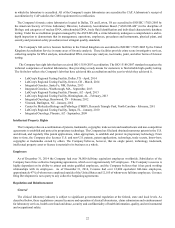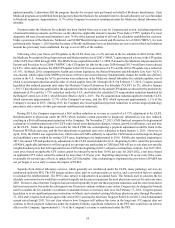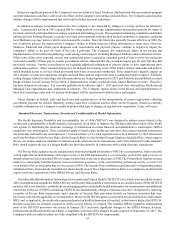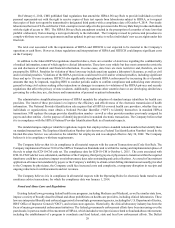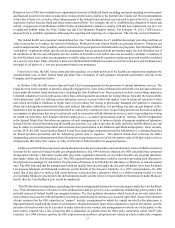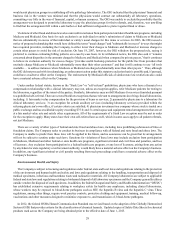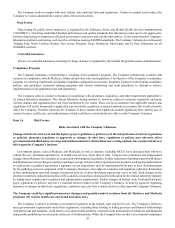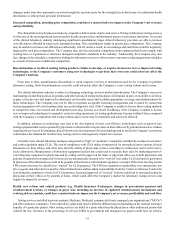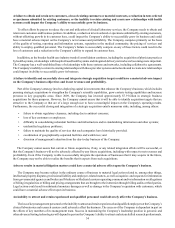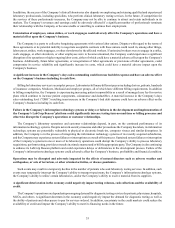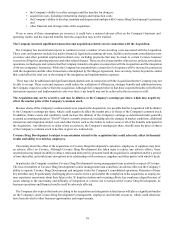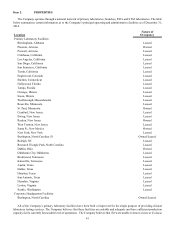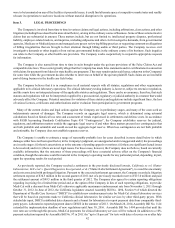LabCorp 2014 Annual Report Download - page 34
Download and view the complete annual report
Please find page 34 of the 2014 LabCorp annual report below. You can navigate through the pages in the report by either clicking on the pages listed below, or by using the keyword search tool below to find specific information within the annual report.32
damages under state laws pursuant to an action brought by a private party for the wrongful use or disclosure of confidential health
information or other private personal information.
Increased competition, including price competition, could have a material adverse impact on the Company’s net revenues
and profitability.
The clinical laboratory business is intensely competitive both in terms of price and service. Pricing of laboratory testing services
is often one of the most significant factors used by health care providers and third-party payers in selecting a laboratory. As a result
of the clinical laboratory industry undergoing significant consolidation, larger clinical laboratory providers are able to increase
cost efficiencies afforded by large-scale automated testing. This consolidation results in greater price competition. The Company
may be unable to increase cost efficiencies sufficiently, if at all, and as a result, its net earnings and cash flows could be negatively
impacted by such price competition. The Company may also face increased competition from companies that do not comply with
existing laws or regulations or otherwise disregard compliance standards in the industry. Additionally, the Company may also
face changes in fee schedules, competitive bidding for laboratory services or other actions or pressures reducing payment schedules
as a result of increased or additional competition.
Discontinuation or recalls of existing testing products; failure to develop, or acquire, licenses for new or improved testing
technologies; or the Company’s customers using new technologies to perform their own tests could adversely affect the
Company’s business.
From time to time, manufacturers discontinue or recall reagents, test kits or instruments used by the Company to perform
laboratory testing. Such discontinuations or recalls could adversely affect the Company’s costs, testing volume and revenue.
The clinical laboratory industry is subject to changing technology and new product introductions. The Company’s success in
maintaining a leadership position in genomic and other advanced testing technologies will depend, in part, on its ability to develop,
acquire or license new and improved technologies on favorable terms and to obtain appropriate coverage and reimbursement for
these technologies. The Company may not be able to negotiate acceptable licensing arrangements and it cannot be certain that
such arrangements will yield commercially successful diagnostic tests. If the Company is unable to license these testing methods
at competitive rates, its research and development costs may increase as a result. In addition, if the Company is unable to license
new or improved technologies to expand its esoteric testing operations, its testing methods may become outdated when compared
with the Company’s competition and testing volume and revenue may be materially and adversely affected.
In addition, advances in technology may lead to the development of more cost-effective technologies such as point-of-care
testing equipment that can be operated by physicians or other health care providers in their offices or by patients themselves without
requiring the services of freestanding clinical laboratories. Development of such technology and its use by the Company’s customers
could reduce the demand for its laboratory testing services and negatively impact its revenues.
Currently, most clinical laboratory testing is categorized as “high” or “moderate” complexity, and thereby is subject to extensive
and costly regulation under CLIA. The cost of compliance with CLIA makes it impractical for most physicians to operate clinical
laboratories in their offices, and other laws limit the ability of physicians to have ownership in a laboratory and to refer tests to
such a laboratory. Manufacturers of laboratory equipment and test kits could seek to increase their sales by marketing point-of-
care laboratory equipment to physicians and by selling test kits approved for home or physician office use to both physicians and
patients. Diagnostic tests approved for home use are automatically deemed to be “waived” tests under CLIA and may be performed
in physician office laboratories as well as by patients in their homes with minimal regulatory oversight. Other tests meeting certain
FDA criteria also may be classified as “waived” for CLIA purposes. The FDA has regulatory responsibility over instruments, test
kits, reagents and other devices used by clinical laboratories and has taken responsibility from the Centers for Disease Control for
classifying the complexity of tests for CLIA purposes. Increased approval of “waived” test kits could lead to increased testing by
physicians in their offices or by patients at home, which could affect the Company’s market for laboratory testing services and
negatively impact its revenues.
Health care reform and related products (e.g. Health Insurance Exchanges), changes in government payment and
reimbursement systems, or changes in payer mix, including an increase in capitated reimbursement mechanisms and
evolving delivery models, could have a material adverse impact on the Company's net revenues, profitability and cash flow.
Testing services are billed to private patients, Medicare, Medicaid, commercial clients, managed care organizations ("MCOs")
and other insurance companies. Tests ordered by a physician may be billed to different payers depending on the medical insurance
benefits of a particular patient. Most testing services are billed to a party other than the physician or other authorized person that
ordered the test. Increases in the percentage of services billed to government and managed care payers could have an adverse


